
Rosaceae, the rose family, is a medium-sized family of flowering plants that includes 4,828 known species in 91 genera.

Saxifragales is an order of angiosperms, or flowering plants, containing 15 botanical families and around 100 genera, with nearly 2,500 species. Of the 15 families, many are small, with eight of them being monotypic. The largest family is the Crassulaceae (stonecrops), a diverse group of mostly succulent plants, with about 35 genera. Saxifragales are found worldwide, primarily in temperate to subtropical zones, rarely being encountered growing wild in the tropics; however, many species are now cultivated throughout the world as knowledge of plant husbandry has improved. They can be found in a wide variety of environments, from deserts to fully aquatic habitats, with species adapted to alpine, forested or fully-aquatic habitats. Many are epiphytic or lithophytic, growing on exposed cliff faces, on trees or on rocks, and not requiring a highly organic or nutrient-dense substrate to thrive.

Witch-hazels or witch hazels (Hamamelis) are a genus of flowering plants in the family Hamamelidaceae, with three species in North America, and one each in Japan (H. japonica) and China (H. mollis). The North American species are occasionally called winterbloom.

Hamamelidaceae, commonly referred to as the witch-hazel family, is a family of flowering plants in the order Saxifragales. The clade consists of shrubs and small trees positioned within the woody clade of the core Saxifragales. An earlier system, the Cronquist system, recognized Hamamelidaceae in the Hamamelidales order.

Cymbidium, commonly known as boat orchids, is a genus of evergreen flowering plants in the orchid family Orchidaceae. Orchids in this genus are epiphytic, lithophytic, terrestrial or rarely leafless saprophytic herbs usually with pseudobulbs. There are usually between three and twelve leaves arranged in two ranks on each pseudobulb or shoot and lasting for several years. From one to a large number of flowers are arranged on an unbranched flowering stem arising from the base of the pseudobulb. The sepals and petals are all free from and similar to each other. The labellum is significantly different from the other petals and the sepals and has three lobes. There are about fifty-five species and sixteen further natural hybrids occurring in the wild from tropical and subtropical Asia to Australia. Cymbidiums are well known in horticulture and many cultivars have been developed. The genome of Cymbidium mannii has been sequenced to study epiphytism and crassulacean acid metabolism.

Fothergilla is a genus of two to four species of flowering plants in the family Hamamelidaceae, native to woodland and swamps of the southeastern United States.
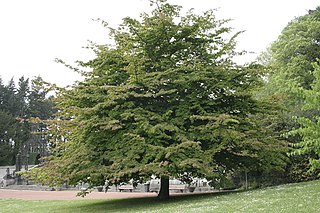
Parrotia persica, the Persian ironwood, is a deciduous tree in the family Hamamelidaceae, closely related to the witch-hazel genus Hamamelis. It is native to Iran's Caspian region and Azerbaijan. It is endemic in the Alborz mountains, where it is found mainly in Golestan National Park.

Altingiaceae is a small family of flowering plants in the order Saxifragales, consisting of wind-pollinated trees that produce hard, woody fruits containing numerous seeds. The fruits have been studied in considerable detail. They naturally occur in Central America, Mexico, eastern North America, the eastern Mediterranean, China, and tropical Asia. They are often cultivated as ornamentals and many produce valuable wood.
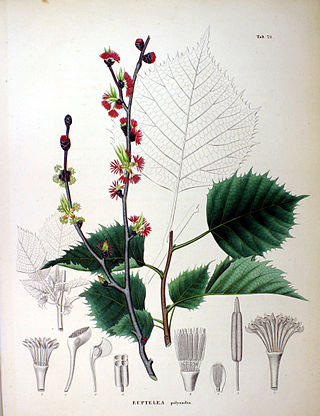
Euptelea is a genus of two species of flowering plants in the monogeneric family Eupteleaceae. The genus is found from Assam east through China to Japan, and consists of shrubs or small trees:

Corylopsis is a genus of nearly 30 species of shrubs in the witch hazel family, Hamamelidaceae, native to eastern Asia with the majority of species endemic to China but with some also in Japan, Korea, and the Himalayas. This genus is also known from the extinct species Corylopsis reedae described from Eocene leaf fossils found in Washington State, USA.
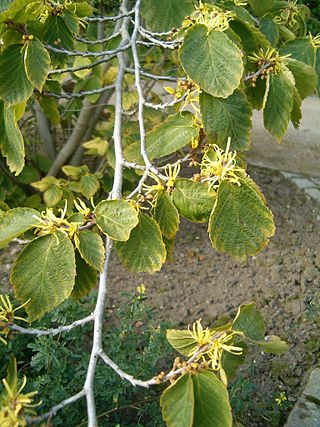
Hamamelis virginiana, known as witch-hazel, common witch-hazel, American witch-hazel and beadwood, is a species of flowering shrub native to eastern North America, from Nova Scotia west to Minnesota, and south to central Florida to eastern Texas.

Loropetalum subcordatum is a species of plant in the Hamamelidaceae family. It is found in China and Hong Kong. Previously considered a separate genus, Tetrathyrium, Loropetalum subcordatum is one of four species of Loropetalum, and is placed in tribe Loropetaleae, subfamily Hamamelidoideae, family Hamamelidaceae of the Saxifragales. Its conservation status is considered vulnerable.

Hamamelis vernalis, the Ozark witchhazel is a species of flowering plant in the witch-hazel family Hamamelidaceae, native to the Ozark Plateau in central North America, in Missouri, Oklahoma, and Arkansas. It is a large deciduous shrub growing to 4 m (13 ft) tall.
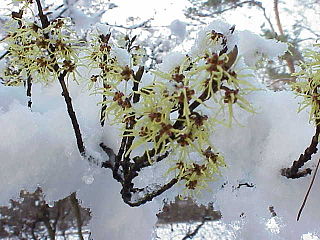
Hamamelis mollis, also known as Chinese witch hazel, is a species of flowering plant in the witch hazel family Hamamelidaceae, native to central and eastern China, in Anhui, Guangxi, Hubei, Hunan, Jiangxi, Sichuan, and Zhejiang.

Exbucklandia is a genus of flowering plants in the family Hamamelidaceae. They are medium to large trees whose natural range is from eastern India through southern China and southward through the Malay Peninsula. In India and China, they are widely cultivated for their impressive foliage and valuable lumber. A few have been grown in the southernmost parts of the United States. To speakers of English, Exbucklandia is generally known as the Pipli tree, from the Bengali name for the species Exbucklandia populnea.

Disanthus is a genus containing two species of flowering plants in the family Hamamelidaceae. The type species, Disanthus cercidifolius, was the only known species until 2017, when a second species, Disanthus ovatifolius was described.

Disanthus cercidifolius is a species of flowering plant in the family Hamamelidaceae. It is native to woodland habitats in China and Japan.

Corylopsis sinensis, the Chinese winter hazel, is a species of flowering plant in the witch-hazel family Hamamelidaceae, native to western China. Growing to 4 m (13 ft) tall and broad, it is a substantial deciduous shrub. With ovate leaves, it produces delicately fragrant, drooping racemes of pale yellow flowers with orange anthers in spring.
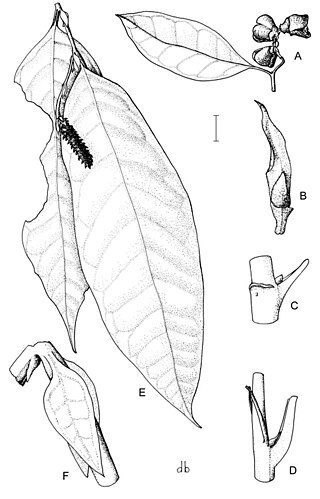
Ostrearia is a monotypic genus - i.e. a genus containing only one species - of plants in the witch-hazel family Hamamelidaceae. It is the first described of three monotypic Australian genera in this family, the others being Neostrearia and Noahdendron. It is most closely related to these genera, as well as Trichocladus from southern Africa and Dicoryphe from Madagascar, and together these five genera form a distinct clade within Hamamelidaceae.

Noadendron is a monotypic genus - i.e. a genus containing only one species - of plants in the witch-hazel family Hamamelidaceae. It is the third described of three monotypic Australian genera in this family, the others being Ostrearia and Neostrearia. It is most closely related to these genera, as well as Trichocladus from southern Africa and Dicoryphe from Madagascar, and together these five genera form a distinct clade within Hamamelidaceae.




















